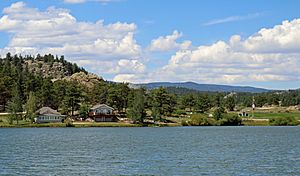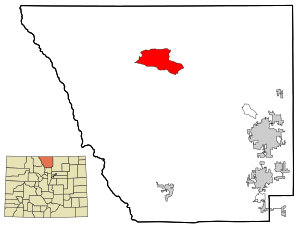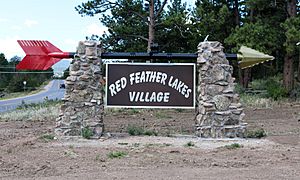Red Feather Lakes, Colorado facts for kids
Quick facts for kids
Red Feather Lakes
|
|
|---|---|

Ramona Lake, with the community park on the right.
|
|

Location of the Red Feather Lakes CDP in Larimer County, Colorado.
|
|
| Country | |
| State | |
| County | Larimer County |
| Government | |
| • Type | unincorporated town |
| Area | |
| • Total | 9.648 sq mi (24.988 km2) |
| • Land | 9.116 sq mi (23.610 km2) |
| • Water | 0.532 sq mi (1.378 km2) |
| Elevation | 8,245 ft (2,513 m) |
| Population
(2020)
|
|
| • Total | 426 |
| • Density | 44.15/sq mi (17.048/km2) |
| Time zone | UTC-7 (MST) |
| • Summer (DST) | UTC-6 (MDT) |
| ZIP Code |
80545
|
| Area code(s) | 970 |
| GNIS feature | Red Feather Lakes CDP |
Red Feather Lakes is a small mountain community in Larimer County, Colorado, United States. It's a special kind of place called a "census-designated place" (CDP), which means it's a community that isn't officially a town but is recognized for counting people. About 426 people lived here in 2020.
Nestled in the Rocky Mountains northwest of Fort Collins, Red Feather Lakes is a charming mountain village. It's surrounded by the beautiful Roosevelt National Forest. The village has a few small general stores where you can find gas, groceries, and gifts. There's also a hardware store, an outdoor sports shop, a coffee shop, a community library, and a post office. You can also find some cozy mountain restaurants here.
One fun spot in the village is Gnome Road, also known as "Elf Lane." This dirt road is perfect for hikers and drivers. As you explore, you'll spot ceramic elves and gnomes, along with tiny fairy doors and faces hidden among the trees, rocks, and bushes.
Contents
History of Red Feather Lakes
For a long time, only Native Americans and a few hunters and trappers visited the Red Feather Lakes area. This changed in the mid-1800s.
Early Settlers and Lumbering
The first known settler was John Hardin, who built a cabin in 1871. Other families, including many of Hardin's children, soon settled nearby. In these early days, most people were ranchers. Lumbering was also very important. Workers called "tie hacks" built trails to haul railroad ties down to Tie Siding, Wyoming. These ties were used to build the transcontinental railroad.
Water Rights and Gold Rush
In 1879, maps showed only one lake in the area, now called Creedmore Lake. As more people arrived, they built toll roads, lakes, and water ditches. Water became a big issue, leading to legal fights over who owned the water.
In September 1886, gold was found a few miles south. A town called Manhattan was started there in 1887. Manhattan grew to 300 people by 1898, but not much gold was found. It became a ghost town a few years later.
Growth and Recreation
By 1895, there were enough people to start a school district and build a schoolhouse. Timbering and sawmills became more important. In 1902, the area became a National Forest Reserve, which later became part of Roosevelt National Forest. This helped manage the timber cutting.
Recreation became popular later on. In 1919, the Fort Collins YMCA built a camp. People from cities like Fort Collins quickly became interested in the area as a summer getaway. In 1923, the name "Red Feather" appeared when the Red Feather Mountain Lakes Association was formed. They wanted to build vacation cabins. The name was inspired by Princess Tsianina Redfeather Blackstone, a Native American singer. People said her grandfather, Chief Redfeather, was buried in the area.
The Red Feather Mountain Lakes Association had big plans. They wanted to build a golf course, tennis courts, and more. Only a nine-hole golf course was actually built. They also planned several hotels, and one was built in 1924. A silver fox farm was also part of the plan. This farm helped the area become known for fishing and summer fun. In 1925, investors claimed they sold 1,900 small lots for cabins. Growth was slow because of the Great Depression and World War II. Many of these original small lots and cabins still exist today.
Civilian Conservation Corps and Modern Times
In 1933, President Roosevelt started the Civilian Conservation Corps (CCC). Several CCC camps operated in the Red Feather Lakes region. Young men in these camps improved roads, cleared forests, fought fires, and built the first fire tower on Deadman Mountain. During World War II, one camp was sold, and another became a POW camp.
The silver fox farm continued until the 1950s, when demand for furs dropped. The property was sold around 1960 and is now part of the Fox Acres Community, which has a golf club and homes.
In 1952, electricity came to Red Feather Lakes. Over the years, new buildings like a fire station and library changed the village. The Red Feather Historical Society collects and keeps detailed information about the area's history. They have a website and run a museum in a historic cabin in the village.
Geography and Lakes
Red Feather Lakes is located in the northern part of Larimer County, Colorado. It's about 24 miles west of U.S. Route 287 at Livermore and 45 miles northwest of Fort Collins.
There are at least 12 named lakes in the community. Some of these include:
- Parvin Lake
- Dowdy Lake
- West Lake
- Snake Lake
- Letitia Lake
- Red Feather Lake
- Lake Ramona
- Hiawatha Lake
- Apache Lake
- Shagwa Lake
- Lake Nokomis
- Lake Erie
All the lakes in Red Feather Lakes eventually flow into Lone Pine Creek. This creek then joins the Cache la Poudre River, which is part of the South Platte River system. The Red Feather Lakes area covers about 24.988 square kilometers, with about 1.378 square kilometers of that being water.
Population Information
The United States Census Bureau first defined Red Feather Lakes as a CDP for the United States Census 2000.
| Red Feather Lakes CDP, Colorado | ||
|---|---|---|
| Year | Pop. | ±% |
| 2000 | 525 | — |
| 2010 | 343 | −34.7% |
| 2020 | 426 | +24.2% |
| Source: United States Census Bureau | ||
 In Spanish: Red Feather Lakes (Colorado) para niños
In Spanish: Red Feather Lakes (Colorado) para niños



